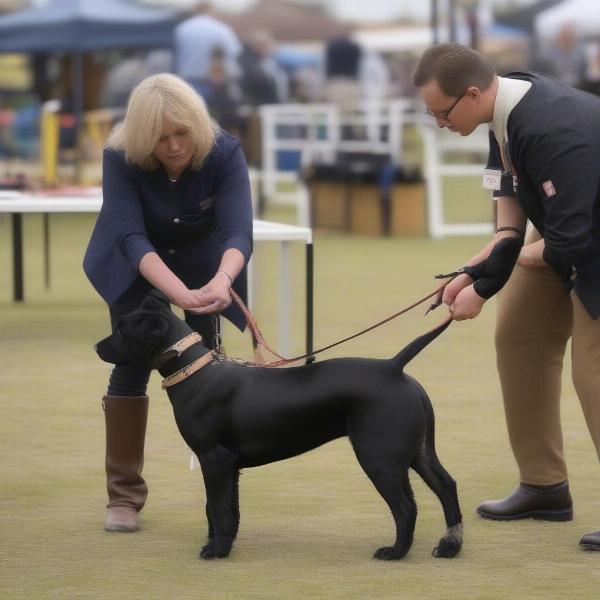Dog show collars play a crucial role in presenting your canine companion in the best possible light. Choosing the right collar can significantly impact your dog’s overall appearance and comfort in the ring. This article explores the world of dog show collars, covering various types, materials, fitting techniques, and tips for selecting the perfect one for your furry friend.
Showcasing your dog’s breed standards requires meticulous attention to detail, and the collar is no exception. A well-chosen collar complements your dog’s conformation, allowing the judge to assess their structure and gait effectively. Conversely, an ill-fitting or inappropriate collar can detract from your dog’s presentation and even hinder their performance.
Types of Dog Show Collars
Different breeds and judging criteria often call for specific collar types. Common choices include:
- Martingale Collars: These collars provide gentle control without choking, tightening slightly when the dog pulls. Martingales are popular for breeds prone to slipping out of traditional collars.
- Slip Collars (or Choke Chains): These collars tighten when the dog pulls, offering quick corrections. However, they require careful handling to prevent injury and are generally not recommended for novice handlers.
- Show Leads: These specialized leads are often thin and unobtrusive, designed to showcase the dog’s neck and shoulders while maintaining control. They are typically used in conjunction with a slip collar.
Choosing the Right Material
The material of the dog show collar is another crucial consideration. Leather, nylon, and metal chain are the most common options.
- Leather: Offers a classic, elegant look and provides a comfortable, secure fit. Leather collars can be easily adjusted and age beautifully.
- Nylon: A lightweight and durable option, nylon collars are easy to clean and come in a wide range of colors. They are ideal for active dogs and wet weather conditions.
- Chain: Often preferred for breeds with thick, dense coats, chain collars offer precise control and a polished look in the ring. However, they can be heavy and may not be suitable for all breeds.
Fitting Your Dog’s Show Collar
A properly fitted collar is essential for both comfort and presentation. The collar should sit high on the dog’s neck, just behind the ears, without being too tight or too loose.
- Too Tight: Can restrict breathing and cause discomfort.
- Too Loose: Risks the dog slipping out or getting tangled.
Consult with experienced handlers or breeders for guidance on fitting your dog’s show collar correctly.
Finding the Perfect Collar: Breed-Specific Considerations
Certain breeds benefit from specific collar styles. For example, sighthounds often look their best in martingale collars or specialized show leads, while breeds with thicker coats might benefit from a chain collar.  A handler fitting a dog show collar correctly
A handler fitting a dog show collar correctly
Conclusion
Choosing the right dog show collar is an important decision that can impact your dog’s performance and overall presentation. By understanding the various types, materials, and fitting techniques, you can select the perfect collar to showcase your canine companion’s best qualities in the ring. Remember, a well-chosen dog show collar is an investment in your dog’s show career and contributes significantly to their success.
FAQ
- What is the best type of dog show collar for a puppy? A lightweight nylon or adjustable leather collar is usually best for puppies. Avoid choke chains or slip collars until they are older and have received proper training.
- How do I clean a leather dog show collar? Use a damp cloth and specialized leather cleaner to wipe away dirt and grime. Condition the leather regularly to maintain its suppleness.
- Can I use a regular collar for dog shows? While technically possible, a regular collar is generally not recommended for dog shows. Show collars are specifically designed to enhance a dog’s presentation and provide the necessary control in the ring.
- Where can I buy dog show collars? Specialty pet stores, online retailers, and dog show supply vendors offer a wide selection of dog show collars.
- How tight should a dog show collar be? The collar should be snug but not restrictive. You should be able to fit two fingers comfortably between the collar and the dog’s neck.
- Are there specific collar requirements for different dog shows? Check the rules and regulations of the specific dog show you are entering, as some may have specific collar requirements for certain breeds or classes.
- What is the difference between a show lead and a regular leash? Show leads are typically thinner and less obtrusive than regular leashes, designed to showcase the dog’s outline without distraction.
ILM Dog is your trusted resource for expert advice on dog care, training, and breed selection. We provide practical, reliable information for dog owners worldwide, from choosing the perfect breed to ensuring your furry friend’s health and well-being. Whether you’re a novice or an experienced dog owner, ILM Dog offers valuable insights into every aspect of responsible dog ownership. Contact us for personalized advice and support: Email: [email protected], Phone: +44 20-3965-8624. Visit ILM Dog today for all your dog-related needs.